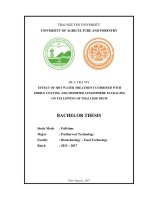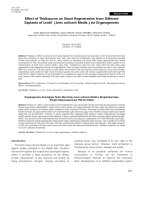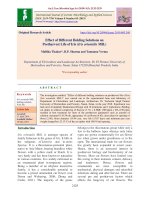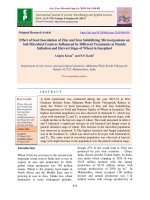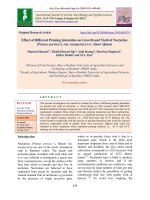Effect of inoculation with vam fungi at different P levels on dry matter production (g plant -1 ) of Tagetes erecta L
Bạn đang xem bản rút gọn của tài liệu. Xem và tải ngay bản đầy đủ của tài liệu tại đây (302.63 KB, 7 trang )
Int.J.Curr.Microbiol.App.Sci (2017) 6(5): 2830-2836
International Journal of Current Microbiology and Applied Sciences
ISSN: 2319-7706 Volume 6 Number 5 (2017) pp. 2830-2836
Journal homepage:
Original Research Article
/>
Effect of Inoculation with VAM Fungi at Different P Levels on Dry Matter
Production (g plant -1) of Tagetes erecta L.
G. Swathi1 and B. Hemla Naik2*
1
Department of Floriculture and Landscape Architecture, College of Horticulture, Mudigere,
Chikmagalur District, Karnataka - 577 132, India
2
University of Agricultural and Horticultural Sciences, Shimoga, Karnataka - 577 225, India
*Corresponding author:
ABSTRACT
Keywords
Marigold, VAM,
phosphorus, Glomus
fasciculatum, G.
mosseae, G. Intraradices,
Dry matter
Article Info
Accepted:
xx April 2017
Available Online:
xx May 2017
A field experiment was conducted to study the response of marigold (Tagetes erecta L.) to
the inoculation of Vesicular Arbuscular Mycorrhizal (VAM) fungi at different P levels. In
this experiment the VAM fungi viz., Glomus fasciculatum (Thaxter) Gerd. and Trappe,
Glomus mossea (Nicol. and Gerd.) Gerd. and Trappe, Glomus intraradices Schenck and
Smith with an un-inoculated control was maintained and three P levels viz., 60, 90, 120 kg
ha-1 were tried. The results brought out that marigold responded well to VAM inoculation
under field conditions. The plants inoculated with G. fasciculatum and given P at 90 kg/ ha
recorded significantly highest total dry matter production in marigold (67.40, 123.02,
154.66 and 155.73 g, respectively) than other species of Glomus fungi and uninoculated
control plants applied with P at 120 kg/ ha and least was observed in uninoculated control
plants supplied with P at 60kg/ ha (44.97, 87.46, 105.53 and 105.73 g, respectively) at 30,
60, 90 and 120 DAT, respectively.
Introduction
Marigold (Tagetes erecta L.) is one of the
most commonly grown commercial flower
crops in India. Increased flower production,
quality of flowers and perfection in the form
of plants are important objectives to be
reckoned in commercial flower production
(Hemlanaik, 2003). Marigold belongs to the
family Asteraceae and genus Tagetes. The
two main popularly grown species in
marigold are Tagetes erecta L. and Tagetes
patula L. which have their origin in Mexico
and South Africa, respectively. Tagetes erecta
L. is popularly known as “African marigold”
while Tagetes patula L. as “French
marigold”. There are several other important
species viz., Tagetes tenuifolia L. (the striped
marigold), Tagetes lucida L. (the sweet
scented marigold), Tagetes minuta L. and
Tagetes lacera L. Mycorrhiza literally means
„fungus
root‟.
The
fungus
obtains
photosynthesis from plant, while the plant is
able to utilize the network of fungal hyphae,
(which effectively act as an extended root
system). The uptake of inorganic nutrients by
plants is influenced by microorganisms in the
rhizosphere. Symbiotic endophytes such as
mycorrhizae are examples of microorganisms
that are involved in the uptake of vital plant
nutrient element, phosphorus.
2830
Int.J.Curr.Microbiol.App.Sci (2017) 6(5): 2830-2836
Phosphorus
is
an
important
plant
macronutrient, making up about 0.2 % of a
plant‟s dry weight. Mycorrhizae are important
for plant P acquisition, since fungal hyphae
greatly increase the volume of soil that plant
roots explore (Smith and Read, 1997). In
certain plant species, root clusters (proteoid
roots) are formed in response to P limitations.
These specialized roots exude high amounts
of organic acids (up to 23 % of net
photosynthesis), which acidify the soil and
chelate metal ions around the roots, resulting
in the mobilization of P and some
micronutrients (Marschner, 1995).
Considering its importance as commercial
flower crop, the study on effect of VAM fungi
on marigold at different phosphorus levels
was initiated.
Materials and Methods
The present investigation was conducted at
experimental unit of Department of
Floriculture and Landscape Architecture,
College
of
Horticulture,
Mudigere,
Chikmagalur district, Karnataka during the
period from October 2013 to February 2014
to know the symbiotic relationship between
marigold and VAM fungi at different
phosphorus levels and its effect on dry matter
production. A factorial experiment was laid
out in Randomised Block Design. There were
12 treatment combinations each three
replications. In the present experiment VAM
fungi (Glomus fasciculatum, G. mosseae, G.
intraradices with an uninoculated control)
and three levels of phosphorus (60, 90, 120 kg
ha-1) were tried in all possible combinations.
Treatment details are as follows,
Factor I = Mycorrhizal species
M1- Glomus fasciculatum (Thaxter) Gerd.
and Trappe.
M2- Glomus mossea (Nicol. and Gerd.)
Gerd. and Trappe.
M3- Glomus intraradices Schenck and
Smith.
Mo- Uninoculated control
Factor II = Phosphorus levels 3
(225kg N + 60kg K2O as constant)
P1- 60 kg P2O5 ha-1
P2- 90 kg P2O5 ha-1
P3- 120 kg P2O5 ha-1
Treatment Combination
Treatment No.
T1
T2
T3
T4
T5
T6
T7
T8
T9
T10
T11
T12
Treatment
M0P1
M0P2
M0P3
M1P1
M1P2
M1P3
M2P1
M2P2
M2P3
M3P1
M3P2
M3P3
Combination
Uninoculation + 60 kg P2O5 ha-1
Uninoculation + 90 kg P2O5 ha-1
Uninoculation + 120 kg P2O5 ha-1
G. fasciculatum + 60 kg P2O5 ha-1
G. fasciculatum + 90 kg P2O5 ha-1
G. fasciculatum + 120 kg P2O5 ha-1
G. mosseae + 60 kg P2O5 ha-1
G. mosseae + 90 kg P2O5 ha-1
G. mosseae + 120 kg P2O5 ha-1
G. intraradices+ 60 kg P2O5 ha-1
G. intraradices + 90 kg P2O5 ha-1
G. intraradices + 120 kg P2O5 ha-1
2831
Int.J.Curr.Microbiol.App.Sci (2017) 6(5): 2830-2836
During nursery stage, four raised seed beds
each of 2.0m x 1.0m x 15cm height were
prepared with a two feet gap in between beds
to avoid contamination. For each species of
Glomus fungi one bed was used and
remaining one was used as uninoculated
control. Thirty days old healthy and uniform
seedlings
were
transplanted
in
an
experimental plot of 3.0 m x 3.0 m with
spacing of 60 x 45 cm and light irrigation was
given immediately after transplantation.
Initial root colonization by VAM fungi were
recorded on the day of transplantation by
staining root system with trypan blue (Phillips
and Hayman, 1970).
The fertilizer dose prescribed for marigold in
transitional tract is 225:120:60 N: P2O5:K2O
per hectare. Nitrogen and Potassium were
applied in the form of urea and murate of
potash respectively. Phosphorus was applied
according to the treatment levels in the form
of rock phosphate. Half the quantity of
nitrogen (112.5 kg/ha) and full dose of
potassium (60kg/ha) viz., P1=60 kg rock
phosphate ha-1, P2=90 kg rock phosphate ha1
and P3= 120 kg rock phosphate ha-1 i.e., 50,
75 and 100 % recommended level
phosphorus) were applied after two weeks of
transplantation by ring method of fertilizer
application. Remaining 50 % of nitrogen was
applied 30 days after transplantation as top
dressing.
flowers and roots of respective stages. This
data formed the basis for computing crop
growth rate.
Results and Discussion
The dry matter production was influenced by
inoculation with Glomus fungi. Plants
inoculated with Glomus fungi were recorded
more
dry
matter
production
than
Uninoculated control.
The data on total dry matter (TDM)
accumulation in marigold as influenced by
inoculation of Glomus fungi at different levels
of P recorded at 30, 60, 90, 120 DAT are
presented in Table 1.
As the growth advanced, TDM accumulation
in marigold plant increased significantly with
increase in age. The influence of Glomus
fungi on TDM accumulation in marigold was
significant at all stages of growth.
At 30 DAT, the plants inoculated with G.
fasciculatum recorded significantly highest
TDM (60.40 g) and it was statistically on par
with G. mosseae (60.17 g) and G.
intraradices showed least TDM production
(50.50 g).
Dry matter production (g/plant)
At 60, 90, 120 DAT, G. fasciculatum recorded
significantly highest TDM (112.43, 140.61 and
141.09 g) and least was observed in G.
intraradices (95.62, 117.49 and 118.10 g).
Dry matter production was estimated at three
different stages of the plant growth. Three
plants were uprooted randomly from the net
plot in each treatment. Then leaves, stem, and
flowers were separated and oven dried at a
temperature of 70 0C, till it reached constant
weight. Dry matter accumulation in different
parts of the plant at different stages were
weighed and recorded in grams. The total dry
matter production was calculated by adding
dry matter accumulation in leaves, stem,
Application of P influenced the TDM
accumulation significantly at all the stages of
growth. Among the P levels 90 kg/ ha
recorded maximum TDM (45.79, 84.58,
106.16 and 106.76 g, respectively) and
minimum was recorded in P level at 60 kg/ ha
(37.94, 72.10, 88.91 and 89.43 g,
respectively) at 30, 60, 90 and 120 DAT,
respectively.
The interaction effect of inoculation of
Glomus fungi and P-fertilization was
2832
Int.J.Curr.Microbiol.App.Sci (2017) 6(5): 2830-2836
significant at all the stages of growth. The
TDM production was increased with the
increase in P levels up to 120kg/ ha in
uninoculated control plants, whereas in the
inoculated plants the TDM production was
increased at P level 90 kg/ ha. The plants
inoculated with G. fasciculatum and given P
at 90 kg/ ha recorded significantly highest
TDM production in marigold (67.40, 123.02,
154.66 and 155.73 g, respectively) than other
species of Glomus fungi and uninoculated
control plants applied with P at 120 kg/ ha
and least was observed in uninoculated
control plants supplied with P at 60kg/ ha
(44.97, 87.46, 105.53 and 105.73 g,
respectively) at 30, 60, 90 and 120 DAT,
respectively.
Table.1 Effect of inoculation with VAM fungi at different P levels on dry matter
production of Tagetes erecta L
Treatment
Mycorrhiza
M0 - Uninoculated control
M1 - Glomus fasciculatum
M2 - Glomus mosseae
M3 - Glomus intraradices
S.Em ±
C.D. (P=0.05)
Phosphorus levels (kg/ha)
P1 - 60
P2 - 90
P3 - 120
S.Em ±
Dry matter production (g plant -1)
30 DAT
60 DAT
90 DAT
120 DAT
54.66
60.40
60.17
50.50
0.16
0.46
101.97
112.43
107.90
95.62
0.07
0.21
127.11
140.61
135.51
117.49
0.03
0.08
127.70
141.09
136.44
118.10
0.04
0.11
37.94
45.79
43.24
0.12
72.10
84.58
78.40
0.05
88.91
106.16
97.84
0.02
89.43
106.76
98.19
0.03
C.D. (P=0.05)
0.35
0.16
0.06
0.09
Interaction (MXP)
M0P1 - Uninoculated control + P @ 60
M0P2 - Uninoculated control + P @ 90
M0P3 - Uninoculated control + P @ 120
M1P1 - Glomus fasciculatum + P @ 60
M1P2 - Glomus fasciculatum + P @ 90
M1P3 - Glomus fasciculatum + P @ 120
M2P1 - Glomus mosseae + P @ 60
M2P2 - Glomus mosseae + P @ 90
M2P3 - Glomus mosseae + P @ 120
M3P1 - Glomus intraradices + P @ 60
M3P2 - Glomus intraradices + P @ 90
M3P3 - Glomus intraradices + P @ 120
S.Em ±
C.D. (P=0.05)
44.97
58.53
60.47
52.48
67.40
61.33
55.23
64.33
60.93
49.67
53.93
47.90
0.47
1.38
87.46
107.35
111.10
98.40
123.02
115.87
102.70
120.03
100.98
95.97
100.71
90.20
0.22
0.63
105.53
135.50
140.31
121.54
154.66
145.65
129.52
150.50
126.52
117.61
125.54
109.32
0.08
0.24
105.73
135.68
141.68
121.66
155.73
145.89
130.96
151.71
126.65
118.58
126.24
109.49
0.12
0.34
2833
Int.J.Curr.Microbiol.App.Sci (2017) 6(5): 2830-2836
Fig.1 Effect of inoculation with VAM fungi at different P levels on
dry matter production (g plant-1) of Tagetes erecta L.
M0 - Uninoculated control
M1 - Glomus fasciculatum
M2 - Glomus mossae
M3 - Glomus intraradices
P1 – 60 kg P2O5 ha-1
P2 – 90 kg P2O5 ha-1
P3 – 120 kg P2O5 ha-1
2834
Int.J.Curr.Microbiol.App.Sci (2017) 6(5): 2830-2836
The dry matter production and its
accumulation in flower depend upon
photosynthetic capacity of plants during
flower
development
period.
The
photosynthetic capacity of the plant depends
upon leaf area and leaf area index (LAI). The
plants inoculated with G. fasciculatum
recorded significantly higher LA (58.05 dm2)
at 120 DAT than other species of Glomus
fungi and uninoculated control (Figure 1).
However, the similar trend was observed in
the interaction between these Glomus fungi
and given P at 90 kg/ ha. Which was
comparable with the uninoculated control
along with the application of P at 120 kg/ ha.
Whereas leaf area index was recorded
significantly highest in the plants inoculated
with G. fasciculatum (5.35), as compared to
other species of Glomus fungi and
uninoculated control.
However these characters were found to be
significantly highest in the plants inoculated
with G. fasciculatum and given P at 90 kg/ ha
(7.34) as compared to other species of
Glomus fungi and superior over uninoculated
control plant and given P at 120 kg/ ha (5.33).
Which eventually might have resulted in
higher photosynthesis, maximum dry matter
production and accumulation in flower
development period, similar results were
observed by Hemlanaik et al., (1995) in China
aster, Farkoosh (2011) in Matricaria
chamomilla and Rajapakse et al., (1989) in
cowpea. Because of increased leaf area per
plant at all the stages of growth inoculation of
VAM also recorded highest leaf area index.
Leaf area duration which is determined by the
LAI of the consecutive growth stages denotes
the magnitude and persistence of leaf area
during the entire crop growth period. The
treatment G. fasciculatum given P at 90kg/ ha
recorded the higher LAD (160.25 days) than
other species of Glomus fungi and it was
comparable with uninoculated control with
given P at 120 kg/ ha (107.95 days). The
increased LAD could be attributed to increase
in leaf area and LAI in the same treatment.
The increase in leaf area has resulted in the
increased dry matter accumulation in the
treated plants with Glomus fungi and may
were found to have higher values for CGR. At
the later stages of crop growth, the decreased
rate of dry matter accumulation noticed this
could be due to the decreased rate of total dry
matter accumulation in plant. The higher
CGR values at 30-60 DAT, indicates that the
rate of increment per unit area and time was
more at early stages due to active crop growth
and also due to arrangement of leaves in the
canopy in such a way avoiding mutual
shading. As the crop growth advanced, the
number of leaves decreases, the size of the
leaves smaller and leaf fall also more and
declining the rate of dry matter accumulation
in the leaves. These results are in accordance
with the results obtained by Brigitta (2011)
and Hemlanaik (2003).
In the present study, with the application of
G. fasciculatum and given P at 90 kg/ ha
significantly higher NAR (1.19 g/ m2/ day)
was observed compared to other Glomus
species and uninoculated control. Net
assimilation rate (NAR), synonymously called
as „unit leaf rate‟, express the rate of dry
weight increases at any instant on a leaf area
basis with leaf representing an estimate of the
size of the assimilatory area. These results
were supported by Shubha (2006).
In conclusion, the dry matter production of
marigold plants inoculated with efficient
VAM fungi and supplied with P at 90 kg ha-1
was comparable even better than the
uninoculated plants supplied with P at 120 kg
ha-1. This indicates the possibility of reducing
P fertilizer application by 25 % of the
recommended dose to marigold by
inoculation with a suitable strain of VAM
fungi, i. e., G. fasciculatum and G. mosseae.
2835
Int.J.Curr.Microbiol.App.Sci (2017) 6(5): 2830-2836
References
BRIGITTA, S. AND SUMALAN, R., 2011,
The influence of arbuscular mycorrhizal
fungi on ornamental characters of
Tagetes patula L. Journal of
Horticulture,
Forestry
and
Biotechnology, 15(1), 170- 174
FARKOOSH, S. S., ARDAKANI, M. R.,
REJALI, F., DARZI, M. T. AND
FAREGH, A. H., 2011, Effect of
mycorrhizal symbiosis and Bacillus
coagolance
on
qualitative
and
quantitative traits of Matricaria
chamomilla under different levels of
phosphorus. Middle-East Journal of
Scientific Research, 8(1): 1-9.
HEMLA NAIK, B., NALAWADI, U. G.,
SREENIVASA, M. N. AND PATIL,
A. A, 1995, Field responses of China
aster (Callistephus chinensis (L) Nees.)
cv. „Ostrich plume‟ to the inoculation of
vesicular-arbuscular mycorrhizal fungi
at different phosphorus levels. Scientia
Horticulturae, 62(1–2): 129–133.
HEMLANAIK, B., 2003, Stability
analysis and standardization of
production technology for flower
and xanthophyll yield in marigold
(Tagetes spp.). Ph.D. Thesis,
submitted to UAS, Dharwad.
MARSCHNER, H., 1992, Mineral nutrition
of higher plants. 2nd edition. Academic
press, San Diego. pp.889.
PHILLIPS, J. M. AND HAYMAN, D. S.,
1970, Improved procedures for clearing
roots and staining parasitic and VA
mycorrhizal fungi for rapid assessment
of infection. Transactions of the British
Mycological Society 55, 158-161.
RAJAPAKSE, S., ZUBERER, D. A. AND
MILLER, J. C., 1989, Influence of
phosphorus levels on VA mycorrhizal
colonization and growth of cowpea
cultivars. Plant soil, 114: 45-52.
SHUBHA, B. M., 2006, Integrated Nutrient
Management for growth, flowering and
xanthophyll yield of Marigold (Tagetes
erecta L.). M. Sc. Thesis, submitted to
UAS, Dharwad.
SMIITH, S. E., READ, D. J., Mycorrhizal
symbiosis. London: Academic Press;
1997.
Vesicular-arbuscular
mycorrhizas; pp. 9–160.
How to cite this article:
Swathi, G. and Hemla Naik, B. 2017. Effect of Inoculation with VAM Fungi at Different P
Levels on Dry Matter Production (g plant -1) of Tagetes erecta L. Int.J.Curr.Microbiol.App.Sci.
6(5): 2830-2836. doi: />
2836
